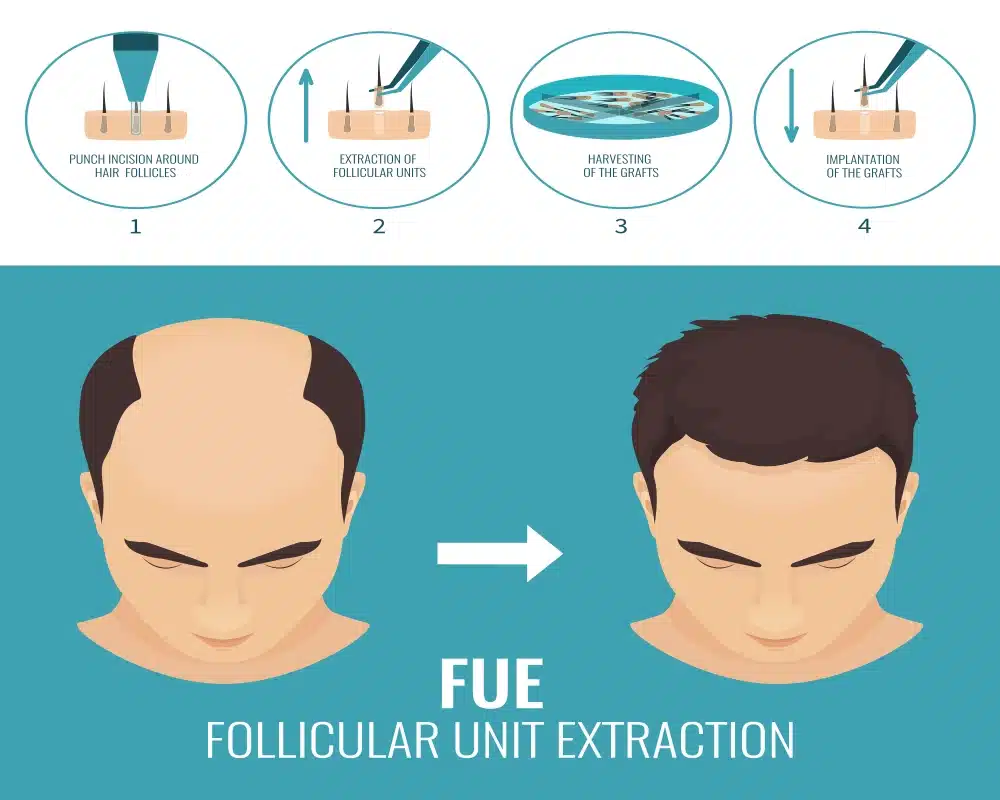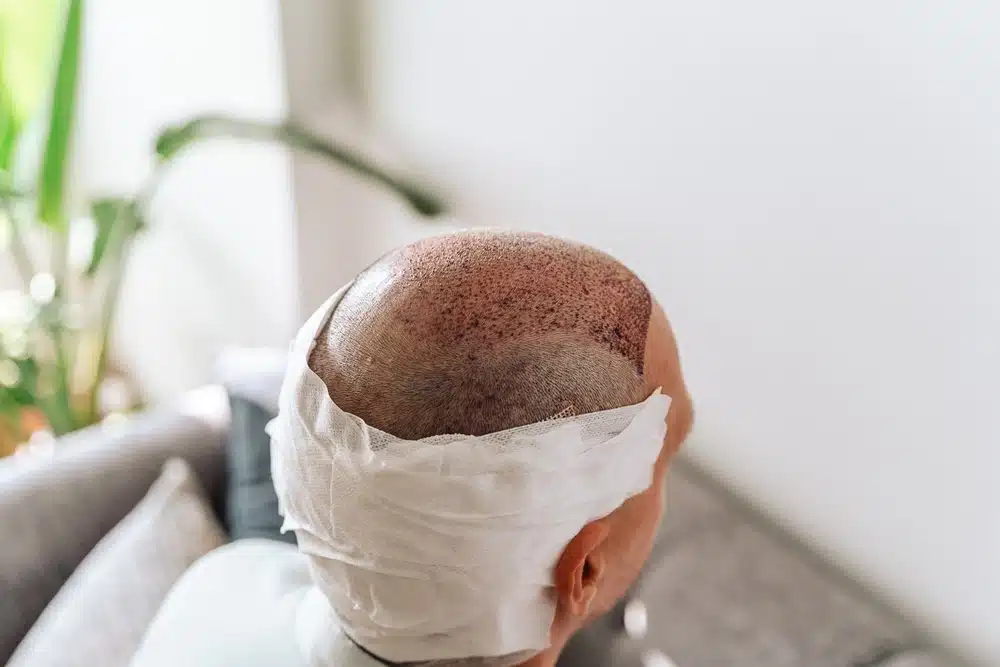Hair loss does not discriminate – it can affect both men and women at any age for a variety of reasons, from genetics to hormonal changes to changing stress levels. [1] It is never an easy thing to go through, and it can have serious psychological and social impacts. The good news is there are hair loss solutions available, including the FUE hair transplant.
FUE hair transplants are a minimally invasive hair restoration surgery that can restore an individual’s hair permanently. However, for the results to be successful, you need to follow proper aftercare. Learn all about FUE aftercare in this comprehensive guide, including what to do and what to avoid.
What is a FUE Hair Transplant?
FUE stands for follicular unit extraction. It is a special type of hair transplant in which a surgeon extracts individual hair follicles from a donor area and then implants them into the recipient area, which is where the patient has experienced hair loss. For precision, the surgeon uses a tiny punch tool to extract the grafts and then makes small incisions to implant the new follicles. It is a minimally invasive type of surgery that is considered safe and restores hair naturally, leading to excellent results in many people who undergo it – particularly those who opt for the top surgeons.
Understanding the FUE Hair Transplant Timeline
Apart from solutions such as wigs and hair pieces, no hair loss treatments lead to instant hair growth results, and the same is true for the FUE hair transplant. So, before diving into the FUE aftercare dos and don’ts, let’s first understand the timeline.
First Week: This part of the initial recovery lasts around a week following the hair transplant procedure. At this point, you will notice scabs on the scalp and perhaps some other symptoms, such as redness and swelling. It can feel quite itchy, too.
Week Two: The symptoms should lessen somewhat at this stage, as the scabs begin to heal. You will likely still experience some itching, but this should mostly subside after around 14 days.
Months One to Two: At this stage, patients experience hair loss. This is completely normal, and the hair will grow back again.
Months Three to Five: This is when the hair starts to grow. It will appear quite thin at first, but it will gradually start to grow more.
Six Months Onwards: Your hair will begin to look full again. Most people experience full results after twelve to eighteen months.
What to Do Following a FUE Hair Transplant
Here, we will focus on what you should do directly following a FUE hair restoration surgery to best facilitate the healing process.
Wash Your Hair Gently
Washing your hair can feel a little scary the first time you do it following a FUE transplant, as your scalp will likely feel a little scabby and sore. To do it properly, use a mild shampoo with lukewarm water and be as slow as you like. It is also best to wait at least twenty-four hours before doing this.
Keep Your Head Elevated While Sleeping
Following your FUE hair transplant, it is essential to avoid placing any pressure on the transplanted area and the donor areas. To do this, keep your head elevated while sleeping. You can invest in a neck pillow that will keep your head up while sleeping, so your scalp does not come into contact with the pillow.
Keep the Scalp Hydrated
Your scalp will likely feel itchy and perhaps sore during the healing process – this is completely normal. After all, you have just gone through surgery. To keep your scalp hydrated and reduce these symptoms, aim to keep the scalp as hydrated as possible by using a saline spray. You can simply spritz this spray onto your scalp throughout the day without having to directly touch the area.
Get Lots of Rest
A big part of post operative care is getting lots of rest! Your body needs to recover from the process and you need to reduce your risk of any complications, so prioritise resting your body. It is always best to take time off work following a hair transplant operation for this reason.
Watch Out for Signs of Infection
An infection following a hair transplant operation may occur. It is important to look out for these signs so you can get in touch with your surgeon and receive the appropriate antibiotics. Signs of infection include:
- Redness
- Swelling
- Pain
- Presence of Pus and Discharge
- A Fever
- Headaches
In some cases, your hair surgeon will provide antibiotics automatically to prevent any risk of developing an infection.
Take Painkillers
Every person’s pain threshold is different. If you experience discomfort following a hair transplant, do not hesitate to take some painkillers. Usually, ibuprofen and paracetamol are enough to alleviate any mild pain you experience. It can also help with irritation and soreness. If you are unsure which painkillers are best to take, speak to your hair surgeon or doctor.
Follow Your Hair Surgeon’s Advice
Your hair surgeon knows what is best for you regarding FUE aftercare. So, follow their advice to a tee. You will usually receive very specific aftercare instructions from them that are tailored to you, so read those carefully. Most of the time your surgeon will also give you an aftercare package (perhaps with a neck pillow and mild shampoo), so be sure to use whatever is in that to facilitate a smoother recovery process.
Get in Touch with Your Surgeon
If you have any worries at all, whether it’s about any symptoms you are showing or questions you have, do not hesitate to get in touch with your surgeon! They are there to help, after all, and they have the expertise to help you understand the full FUE aftercare process.
What Not to Do Following a FUE Hair Transplant
These are the things you must avoid during the FUE transplant aftercare process.
Strenuous Exercise
It may be challenging for some to avoid exercise after a hair transplant, but remember that this is a surgical procedure, and you need time to recover fully. Exercise will only inhibit good results, as it can raise your blood pressure and even cause newly transplanted hair to fall out before it has a chance to grow. So, wait at least fourteen days before doing any strenuous exercise like running or lifting weights. After one week, you can start doing some lighter exercises, such as yoga.
Expose Your Head to the Sun
Your scalp should be protected from UV rays for proper FUE aftercare. The sun can seriously damage your transplanted grafts, and the area will be extremely sensitive. So, if you have to go outside, be sure to wear a hat. Generally, though, it’s best to stick indoors when you can. Do this for the first month.
Smoke
Your surgeon should inform you that smoking following a FUE hair transplant is a big no. The reason for this is that smoking can slow down blood circulation to the scalp, preventing a good healing process and even stopping new hair growth, which is why you went through the surgery to begin with! If you are a smoker, it’s best to find alternatives like nicotine gum, patches, or pouches.
Style or Dye Your Hair
Please note that after a hair transplant, styling or dying your hair should absolutely be avoided. Your scalp is still in the healing process, after all, so the last thing you want to do is apply harsh chemicals to the area!
Panic at the Shedding Phase
No patient grows a full head of hair directly following a hair transplant! In fact, there is the shedding phase to go through, which usually occurs a couple of weeks after the surgery and may even last a few months. Some patients panic at this stage, assuming that the operation was not a success, but this is not the case. Shedding is completely normal, and it’s important not to panic, as high-stress levels can impact the outcome!
Why is FUE Aftercare So Important?
You now know the biggest dos and don’ts following a FUE hair transplant. You may now wonder, why is this all so important?
It is all about protecting your new grafts, which are the areas where new hair will eventually grow through, giving you that full head of hair you’ve been wanting. Directly following the surgery, these grafts are very sensitive, especially if exposed to sweat, UV rays, or chemicals. It’s your job to protect these grafts by being as gentle as possible.
With proper aftercare, you can prevent an infection, reduce the amount of scarring, and boost the healing process. All of this will lead to greater results. Check out our patients gallery to see what looking after your scalp following a FUE hair transplant can lead to!
Aftercare FUE Hair Transplant: In Summary
A FUE hair transplant is an excellent way of achieving thicker, fuller hair after experiencing hair loss. For best results, it is imperative to follow aftercare advice – that way, you will end up with the hairline of your dreams.
Of course, to get to that stage, you need to find the right hair transplant surgeon. If you’re still in the research phase, download our hair track app, as this puts you in touch with the top FUE surgeons in the business.
Sources:
- https://my.clevelandclinic.org/health/diseases/21753-hair-loss




